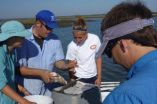(Press-News.org) Massachusetts General Hospital (MGH) investigators have identified the mechanism by which an enzyme produced in the intestinal lining helps to maintain a healthy population of gastrointestinal microbes. In their report in American Journal of Physiology – Gastrointestinal and Liver Physiology, the research team describes finding that intestinal alkaline phosphatase (IAP) promotes the growth of beneficial bacteria by blocking the growth-inhibiting action of adenosine triphosphate (ATP) – an action first described in this paper – within the intestine.
"We found that ATP is a natural inhibitor of bacteria in our intestines and that IAP promotes the growth of 'good' bacteria by blocking ATP," says Richard Hodin, MD, of the MGH Department of Surgery, senior author of the report which has been released online. "By helping to keep these healthy bacteria happy, IAP protects us against dangerous pathogens that can get the upper hand when the balance is disrupted."
The beneficial bacteria and other microbes that normally populate the human digestive system contribute to the digestive process and also prevent the proliferation of any disease-causing bacteria that may be present. A drop in the number of beneficial species – which may be caused by antibiotic treatment, poor nutrition or other health conditions – can allow the population of harmful bacteria to rise, contributing to serious medical problems including chronic diarrhea from pathogenic species such as C. difficile, inflammatory bowel disease, and metabolic syndrome.
Previous research by Hodin's team found that IAP keeps pathogenic bacteria in the gastrointestinal tract from passing through the intestinal wall, and a 2010 study in mice revealed that the enzyme plays an important role in maintaining levels of beneficial bacteria, including restoring levels reduced by antibiotic treatment. However, that study also showed that IAP does not directly promote bacterial growth, leaving exactly how the enzyme helps maintain the microbial population an open question that the current study was designed to investigate.
A series of experiments first confirmed that mice lacking intestinal IAP had significant reductions in populations of several important bacterial species. Hypothesizing that IAP may act by blocking a growth-inhibiting activity of one of its target molecules, the researchers tested how well bacteria in stool samples would grow in the presence of four known IAP targets. Among the tested targets, only ATP significantly reduced bacterial growth; and ATP's inhibitory effects were reversed by application of IAP. Best known as the primary energy supply within cells, ATP also acts as a signaling molecule both inside and outside of cells, and this study is the first to identify such an activity for ATP within the gastrointestinal system.
Experiments in living mice revealed that IAP knockout animals had 10 times the normal level of ATP within their intestines and that fasting animals, in which IAP levels would be expected to drop, also had elevated intestinal ATP. Adding ATP to the intestines of mice in which IAP activity had been inhibited reduced levels of beneficial E.coli bacteria in the animals' digestive systems. Altogether the results show that ATP inhibits the growth of intestinal bacteria in mice and that IAP's growth-promoting effects result from the enzyme's inactivation of ATP and possibly of related molecules.
"Now we need to find out whether IAP also promotes the growth of beneficial intestinal bacteria in humans," says Hodin, who is a professor of Surgery at Harvard Medical School. "If it does, IAP-based therapies could offer a simple and safe approach to treating the millions of patients who suffer serious health problems caused by disruptions to intestinal microbial balance."
INFORMATION:
Mahdu Malo, PhD, MBBS, of MGH Surgery is lead author of the American Journal of Physiology – Gastrointestinal and Liver Physiology report. Additional co-authors are Omeed Moaven, MD, Nur Muhammad, Brishti Biswas, Sayeda Alam, Konstantinos Economopoulos, MD, Sarah Shireen Gul, Sulaiman Hamarneh, MBBS, Nondita Malo, Abeba Teshager, Mussa Mohamed, MD, and Qingsong Tao, MD, PhD, MGH Surgery; Elizabeth Hohmann, MD, MGH Infectious Disease; Shaw Warren, MD, MGH Pediatrics; Sonoko Narisawa, PhD, and José Luis Millán, PhD, Sanford-Burnham Medical Research Institute; and Simon Robson, PhD, MBChB, Beth Israel Deaconess Hospital.
The study was supported by National Institutes of Health grants R01DK050623, R01DK047186 and P30DK40561, and by a Grand Challenge Exploration Grant from the Bill and Melinda Gates Foundation.
Massachusetts General Hospital, founded in 1811, is the original and largest teaching hospital of Harvard Medical School. The MGH conducts the largest hospital-based research program in the United States, with an annual research budget of more than $775 million and major research centers in AIDS, cardiovascular research, cancer, computational and integrative biology, cutaneous biology, human genetics, medical imaging, neurodegenerative disorders, regenerative medicine, reproductive biology, systems biology, transplantation biology and photomedicine.
Study identifies mechanism by which intestinal enzyme maintains microbial balance
Findings could lead to new therapies for health problems caused by lack of 'good bacteria'
2014-05-09
ELSE PRESS RELEASES FROM THIS DATE:
NASA sees system 90E just after earthquake hit Mexico's Guerrero State
2014-05-09
VIDEO:
This movie of imagery from NOAA's GOES-West satellite from May 7 at 14:15 UTC to May 9 at 14:15 UTC shows System 90E's progression and movement on land in southwestern...
Click here for more information.
As the dissipating tropical low pressure system known as System 90E continued rain on Guerrero State in southern Mexico, the U.S. Geological Survey reported a 6.4 magnitude earthquake occurred there on Thursday, May 8 around noon local time (1 p.m. EDT). NASA's Aqua satellite ...
Bioprinting a 3D liver-like device to detoxify the blood
2014-05-09
Nanoengineers at the University of California, San Diego have developed a 3D-printed device inspired by the liver to remove dangerous toxins from the blood. The device, which is designed to be used outside the body -- much like dialysis – uses nanoparticles to trap pore-forming toxins that can damage cellular membranes and are a key factor in illnesses that result from animal bites and stings, and bacterial infections. Their findings were published May 8 in the journal Nature Communications.
Nanoparticles have already been shown to be effective at neutralizing pore-forming ...
Rotational X-ray tracking uncovers hidden motion at the nanoscale
2014-05-09
Over the past two decades or so, there has been increasing interest and development in
measuring slow dynamics in disordered systems at the nanoscale, brought about in part from a demand for advancements in the food and consumer products industries.
Some of the techniques that have been developed over recent years to study the dynamic properties of these materials include X-ray photon correlation spectroscopy (XPCS) and speckle visibility spectroscopy (SVS). Both of these techniques however suffer from some fundamental limitations ranging from the use of only specialized ...
Study predicts adult obesity prevalence in almost all European countries by 2030
2014-05-09
Amsterdam, 9 May. Rates of obesity and overweight in both male and females are projected to increase in almost all countries of Europe by 2030, according to a statistical modelling study. However, the forecast rates vary throughout the 53 Euro-region countries, with projected male obesity levels ranging from 15% in the Netherlands and Belgium, to 47% in Ireland. The highest obesity prevalence in females was projected in Ireland (47%), and the lowest in Romania (10%).
The study, from investigators which included the WHO Regional Office for Europe, was presented at the ...
Colonization of Brazil by the cattle egret
2014-05-09
In recent years the cattle egret (Bubulcus ibis) has colonized American continent. Invasive species are a worldwide problem and studies are devoted to assess the damage they cause to local species populations. Thus, the process of colonization of a new territory that has continental dimensions such as Brazil offers an excellent opportunity to examine how non-native species disperse, adapt and survive. A new study of the colonization patterns of the cattle egret in Brazil, published in the open access journal NeoBiota, offers a new take on the study of alien species.
The ...
Research indicates coyote predation on deer in East manageable
2014-05-09
Coyotes are a major predator of white-tailed deer across the East, especially fawns born each spring, but wildlife managers nonetheless are able to stabilize and even grow deer herds, according to researchers in Penn State's College of Agricultural Sciences.
Coyotes -- Canis latrans -- are a relatively recent arrival to eastern North America, appearing first in the region in noticeable numbers in the 1970s. They are a significant source of deer mortality and most often prey on whitetails in the earliest months of their lives. Coyotes have long inhabited the American West.
With ...
Larger percentage of Texas Hispanics have enrolled in Health Insurance Marketplace plans
2014-05-09
HOUSTON – (May 9, 2014) – Texas Hispanics were more than twice as likely as whites to have enrolled in health insurance plans offered through the Affordable Care Act's Health Insurance Marketplace between September 2013 and March 2014, according to a report released today by Rice University's Baker Institute for Public Policy and the Episcopal Health Foundation.
The report also found that Hispanic adults in Texas experience more difficulty in affording health services than white adults and are three times as likely to be uninsured. In addition, Hispanic respondents ...
Role of middle predators in reef systems
2014-05-09
Northeastern University researchers at the Marine Science Center have shown that the behavior of the "middle child" in the predator-prey food chain plays a strong role in determining how the reef as a whole will fare. The new research from the team was published online on Tuesday in the journal Ecology Letters.
Northeastern ecologist David Kimbro, who claims to have watched a lot of TV growing up, particularly The Brady Bunch, compares the "middle child" behavior of oyster reefs to the show: "You could kind of get a flavor for how an episode was going to turn out based ...
Honolulu-based study reveals shorter men live longer
2014-05-09
Short height and long life have a direct connection in Japanese men, according to new research based on the Kuakini Honolulu Heart Program (HHP) and the Kuakini Honolulu-Asia Aging Study (HAAS).
"We split people into two groups – those that were 5-foot-2 and shorter, and 5-4 and taller," said Dr. Bradley Willcox, one of the investigators for the study and a Professor in the University of Hawai`i (UH) John A. Burns School of Medicine's Department of Geriatric Medicine. "The folks that were 5-2 and shorter lived the longest. The range was seen all the way across from being ...
Study strengthens link between neonicotinoids and collapse of honey bee colonies
2014-05-09
Boston, MA — Two widely used neonicotinoids—a class of insecticide—appear to significantly harm honey bee colonies over the winter, particularly during colder winters, according to a new study from Harvard School of Public Health (HSPH). The study replicated a 2012 finding from the same research group that found a link between low doses of imidacloprid and Colony Collapse Disorder (CCD), in which bees abandon their hives over the winter and eventually die. The new study also found that low doses of a second neonicotinoid, clothianidin, had the same negative effect.
Further, ...
LAST 30 PRESS RELEASES:
Heart-brain connection: international study reveals the role of the vagus nerve in keeping the heart young
Researchers identify Rb1 as a predictive biomarker for a new therapeutic strategy in some breast cancers
Survey reveals ethical gaps slowing AI adoption in pediatric surgery
Stimulant ADHD medications work differently than thought
AI overestimates how smart people are, according to HSE economists
HSE researchers create genome-wide map of quadruplexes
Scientists boost cell "powerhouses" to burn more calories
Automatic label checking: The missing step in making reliable medical AI
Low daily alcohol intake linked to 50% heightened mouth cancer risk in India
American Meteorological Society announces Rick Spinrad as 2026 President-Elect
Biomass-based carbon capture spotlighted in newly released global climate webinar recording
Illuminating invisible nano pollutants: advanced bioimaging tracks the full journey of emerging nanoscale contaminants in living systems
How does age affect recovery from spinal cord injury?
Novel AI tool offers prognosis for patients with head and neck cancer
Fathers’ microplastic exposure tied to their children’s metabolic problems
Research validates laboratory model for studying high-grade serous ovarian cancer
SIR 2026 delivers transformative breakthroughs in minimally invasive medicine to improve patient care
Stem Cell Reports most downloaded papers of 2025 highlight the breadth and impact of stem cell research
Oxford-led study estimates NHS spends around 3% of its primary and secondary care budget on the health impacts of heat and cold in England
A researcher’s long quest leads to a smart composite breakthrough
Urban wild bees act as “microbial sensors” of city health.
New study finds where you live affects recovery after a hip fracture
Forecasting the impact of fully automated vehicle adoption on US road traffic injuries
Alcohol-related hospitalizations from 2016 to 2022
Semaglutide and hospitalizations in patients with obesity and established cardiovascular disease
Researchers ‘listen in’ to embryo-mother interactions during implantation using a culture system replicating the womb lining
How changing your diet could help save the world
How to make AI truly scalable and reliable for real-time traffic assignment?
Beyond fragmented markets: A new framework for efficient and stable ride-pooling
Can shape priors make road perception more reliable for autonomous driving?
[Press-News.org] Study identifies mechanism by which intestinal enzyme maintains microbial balanceFindings could lead to new therapies for health problems caused by lack of 'good bacteria'





